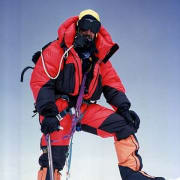Climbing Iconic Mount Rainier in 2025

Preparing to Climb Mt. Rainier
Whether a first-time climber, or a seasoned veteran, preparation for this the Mt. Rainier journey begins now. The actual climbing season begins around late May and runs through September. Of course, very experienced mountaineers often attempt winter ascents on Mt. Rainier, though this guide focuses on late-spring and summer climbing. This chapter focuses on pre-climbing season conditioning and introduces gear, technical requirements, and an introduction to routes. Mount Rainier National Park
Standing 14,410 feet, this massive stratovolcano presents a formidable challenge for climbers of all levels. With 25 glaciers comprising the rugged mountain, climbers face the most glaciated peak in the lower-48 states, second only to Denali and other mountains in Alaska. The mountain's volcanic nature and changing weather conditions add to its complexity. The imposing glaciers and unpredictable weather demand meticulous preparation from every climber.
Consistent Physical Conditioning
Preparing your body for the rigors of high-altitude climbing requires a combination of cardiovascular training, strength building, and hiking with a loaded backpack. Activities including running, cycling, hiking and stair climbing increase your stamina. Keep doing such activities consistently all winter. Two conditioning elements will supercharge your ‘mountaineering’ fitness: Walking uphill and carrying weight on your back. Incorporate more of each into your conditioning program throughout the winter and spring.
Weight training adds a critical factor in any conditioning program and fits nicely into climbing preparation. While I recommended full-body weight and resistance training, pay particular attention to leg exercises and core strength training to prepare for the unique strains of climbing. The key to your climbing preparation starts with moving, and with increasing intensity. By early spring, at least half of your cardio routine should include going uphill – whether hiking, stair climbing, or riding your bike.
Improve and Practice Technical Skills
Climbing Mt. Rainier requires proficiency in mountaineering skills including crevasse rescue, snow and ice climbing techniques, glacier travel, and rope work. Consider joining a mountaineering course to brush up on essential skills.
I recommend picking up a copy of 'Mountaineering: The Freedom of the Hills', still the foremost, comprehensive guide to climbing. Written by a team of over 40 mountaineering experts, the book literally covers every aspect of mountaineering. If you have signed up for a guided climb on Rainier, your expert guides will provide you with all the necessary technical training required to climb.
Check Your Gear - It's Critical
Invest in high-quality gear. Essentials include crampons, ice axe, harness, rope, and helmet. Layer your clothing choices to adjust to the mountain's varying temperatures. Become comfortable and proficient with your equipment, and break in your mountaineering boots to avoid discomfort during the climb. Your equipment needs will vary depending on whether you are part of a guided expedition, or on an independent climb. Reputable mountaineering stores add value in discussing gear options.
Knowledge of the Route
Familiarize yourself with the route you plan to take. Whether it's the popular Disappointment Cleaver or the Emmons Glacier routes, understanding the intricacies of your path provides invaluable information. Studying topographical maps and consulting with experienced climbers or guides can provide crucial insights. Climbing Routes on Mt. Rainier
Acclimatization, Weather and Permits
Mt. Rainier's altitude can lead to altitude sickness, making acclimatization critical. Spend several days hiking at increasing elevations or consider camping at higher altitudes before your ascent. Constantly monitor forecasts leading up to your climb and be prepared for sudden changes. Also, ensure that you have the necessary permits. The National Park Service limits the number of climbers on Mt. Rainier, so secure your permit well in advance. Guided climbs will secure the permits for you. Related Adventure Article
